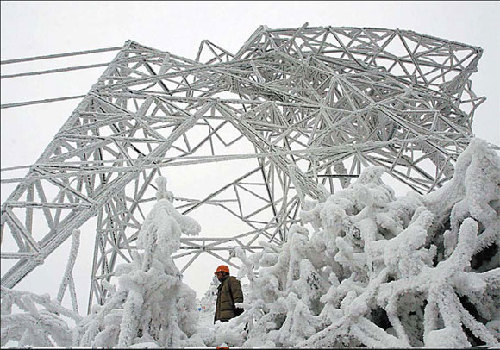Reconstruction after snow crisis unleashes big orders
Updated: 2008-03-03 07:19
Zhang's company received 300 million yuan worth of orders for power cables last month, mostly from the snowstorm-stricken provinces in south China. As a result, some 300 workers like Zhang gave up their holiday and churned out 2 tons of cables in the first two weeks of February that were immediately dispatched to Jiangxi, Guangdong and Guizhou provinces.

"Our production capacity has been put in top gear to meet orders from the regions hit by the blizzards," says Jiang Huajun, director of Far East Holding Group Co, parent of the cable maker. "Cable sales will grow at least 50 percent this years, double our previous target."
The Jiangsu-based cable maker is among the first to benefit from the massive reconstruction work following the worst snowstorms to hit China in 50 years. The inclement weather, wreaking havoc in much of the nation, has caused a direct economic loss of 151.65 billion yuan. The reconstruction budget, mostly in infrastructure, will boost companies dealing in electricity and telecom equipment.
Power equipment makers like Far East may benefit the most from the tens of billions of dollars planned to rebuild and upgrade the power grid damaged by the snowstorms. The heavy snow hit more than 36,000 power lines and nearly 2,000 electric substations, causing a direct loss of 18 billion yuan, according to the State Electricity Regulatory Commission.
"The massive repair work will boost equipment makers," says Wang Peng, an analyst from China Merchants Securities Co Ltd.
State Grid, the bigger of China's two power transmission companies, has earmarked 39 billion yuan to renovate and rebuild the transmission infrastructure damaged in the snow.
Four out of 26 provinces in the State Grid's network were hit the hardest. The worst hit were in Hunan and Jiangxi provinces. The company says its direct losses amounted to 10.5 billion yuan by February 20.
The snow disaster has also raised the question if the country needs to upgrade the design standards of its power grids in the affected areas. The National Development and Reform Commission says it is looking into the issue.
"If higher standards are employed, it will substantially balloon the nation's already grand investment budget for the power grid system," says Wang.
High-voltage power lines in China are designed to withstand about 10-15 mm of ice. But during the recent snowstorms, the average was twice that, and up to 60 mm in some places. Grid operators would have to triple the building costs to enable the lines bear up to 30 mm of ice, a source from the State Grid says.
Grid operators have already been investing heavily over that past few years to enable the power transmission network support the booming economy. For example, State Grid planned to invest 253.2 billion yuan to improve its transmission network last year, up almost 40 percent from 2006. Another 300 billion yuan will be spent in 2008 and 2010 each on power grids.
A number of equipment vendors have already benefited from the investment spree. Homegrown Tebian Electric Apparatus, a Xinjiang-based company, was poised to replace Switzerland's ABB to become the world's largest maker of transformers in 2007. The company's Shanghai-listed A shares more than quadrupled in value last year, beating the benchmark Shanghai Composite Index that almost doubled.
Besides power equipment vendors, some other companies will also profit from the spending to rebuild key infrastructures in telecom, railways and roads. In the past two months, China Telecom, China Mobile and China Unicom, the three major telecom operators, registered a direct loss of 2.79 billion yuan in equipment and facilities. China Telecom alone had 100,000 of its telecom stations damaged in the blizzards.
Shenzhen-based telecom equipment supplier ZTE Corp is expected to corner most of the telecom operators' 1 billion yuan repairs budget, according to Chen Yunhong, an analyst with Sinolink Securities.
The reconstruction process may also prove to be a boon for construction materials such as concrete and steel. According to the Ministry of Civil Affairs, 485,000 buildings collapsed in the snowstorms while the roads in the storm-stricken areas would need a major facelift as the chemicals used to melt the snow left the roads badly damaged.
"Railways is another sector that needs attention," says Chu Hai, transport analyst with Sinolink Securities. "The government is likely to speed up its already aggressive investment budget to ease the transport bottleneck."
The blizzards paralyzed much of the nation's railway network and froze the coal transports from China's north to south. This, in turn, forced the power plants in southern provinces to shut down, exacerbating the chaos.
China has been investing heavily in its railway network, which carries 25 percent of the world's railway traffic on just 6 percent of the total tracks, according to the World Bank.
The nation is trying to boost its operational railway lines from the current 78,000 km to more than 90,000 km by 2010. The government has earmarked 1.25 trillion yuan for network construction during the 2006-2010 Plan period, four times the amount set aside in the previous Plan period.

|
|
|
||
|
||
|
|
|
|